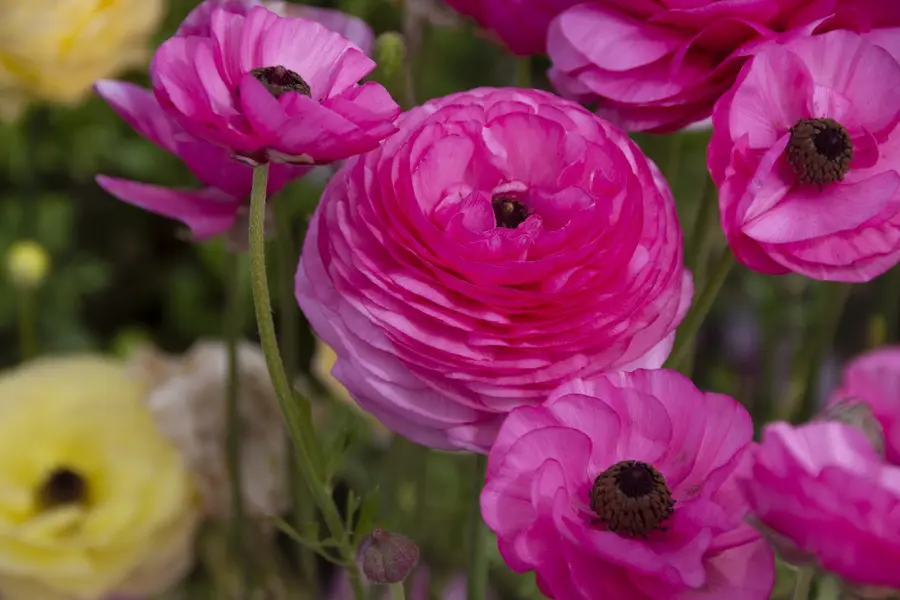This post contains affiliate links. If you buy something from one of our links we may earn a commission. Thanks

Discover the secrets of growing Ranunculus in pots! Our friendly guide walks you through, ensuring your buttercups bloom beautifully in your indoor or outdoor space.
Growing Ranunculus in pots requires well-drained soil and a sunny location. Plant tubers 1-2 inches deep and water moderately.
Ensure at least six hours of sunlight and maintain a temperature range of 45-60°F. Fertilize once a month with a balanced fertilizer for best blooms.
Whether you’re an experienced green thumb or a newbie to gardening, the idea of growing Ranunculus in pots can be truly exciting.
These radiant flowers, also known as Persian Buttercups, bring a burst of color to any space, indoor or outdoor.
With their ruffled petals and long-lasting blooms, it’s no wonder they’re a gardener’s dream.
So, if you’re ready to embark on a delightful gardening journey, let’s dive into the art and science of cultivating these stunning beauties in pots!
Introduction to Persian Buttercups (Ranunculus Flowers
Welcome to the world of Persian Buttercups, or as they’re scientifically known, Ranunculus flowers.
These stunning blossoms are the stars of any garden or indoor arrangement with their vibrant hues and delicate, layered petals.
In this post, we’ll be covering everything from the rich history of these elegant flowers to the best practices for planting Ranunculus bulbs and taking care of these beauties.
We’ll even touch on tips for creating cut flowers for your home and how to prepare your Ranunculus plants for the following season.
So, grab your gardening gloves, and let’s get started!
Unraveling the Beauty of Persian Buttercups
Persian Buttercups, also known as Ranunculus flowers, are a gardeners’ delight.
With their vibrant and varied colors, from crisp whites to deep reds, they bring a splash of joy to any garden.
These flowers are not just pretty faces, but they come with an interesting backstory too.
Originating from Asia, Ranunculus flowers have made their way around the globe, gracing gardens and flower beds with their presence.
Planting Ranunculus Bulbs for Blooming Success
The journey of growing beautiful Ranunculus flowers starts with planting the bulbs.
These bulbs, or more accurately, corms, are the powerhouse of the plant. They store all the nutrients required for the plant’s growth.
The best time to plant them is in early spring or late winter, depending on your hardiness zone.
But don’t worry, we’ll delve into the specifics of when and how to plant these corms to ensure your Ranunculus plants thrive.
Ensuring a Blooming Display with Proper Care
Taking care of your Ranunculus plants is not as daunting as it might seem.
With a little attention to watering, ensuring good drainage, and proper sunlight, your Ranunculus flowers will reward you with a stunning display.
From managing common issues like powdery mildew to deadheading spent flowers, we’ve got you covered.
We’ll go over all the ins and outs of maintaining a healthy Ranunculus plant, so you can enjoy their beautiful blooms all season long.
How to grow Ranunculus: planting and care tips
Are you ready to delve into the rewarding journey of growing Ranunculus?
Whether you’re an experienced gardener or a budding green thumb, these vibrant blooms make a delightful addition to any outdoor space or indoor pot collection.
From the moment you plant your first ranunculus bulb to the joyful day you see the first blossoms, we’ll guide you through every step of the process.
So, let’s explore together the key planting and care tips for nurturing your Ranunculus, ensuring a dazzling display that’s bound to be the talk of the neighborhood.
From choosing the right planting spot and preparing the soil to mastering watering and care routines, we’re here to make sure your Ranunculus thrives.
Get ready to embark on this gardening adventure!
Perfect Timing: When to Plant Ranunculus Bulbs
If you’re keen on growing Ranunculus, timing is everything.
You’ll achieve the best results when you plant the bulbs, also known as corms, in early spring or late winter.
This gives them ample time to establish themselves before the growing season.
However, if you live in a warmer climate, late summer to early fall planting can also yield fantastic results.
Remember, Ranunculus are cool-season flowers, so they enjoy a head start before the hot summer months roll in.
Setting the Stage: Best Time and Conditions for Planting
The best time to plant your Ranunculus bulbs is on a day when the soil is dry and the weather is cool.
This makes it easier to work the soil and reduces the risk of the bulbs rotting.
As for the conditions, Ranunculus prefers a sunny spot with good drainage.
They love soaking up the full sun, so a location that gets at least six hours of sunlight is ideal.
Building Foundations: Soil and Drainage Requirements
Let’s talk soil. Ranunculus aren’t too fussy, but they do love well-drained soil.
This is where a mix of coco coir and perlite can work wonders.
Coco coir provides a fantastic moisture-holding capacity while still promoting good drainage, and perlite further enhances this drainage while also promoting root health.
This combo creates a soil environment that’s just right for your Ranunculus, moist but never waterlogged.
Remember, whether you’re growing these beauties in garden beds or pots, drainage is key.
A well-draining soil mix can make the difference between flourishing Ranunculus flowers and a disappointing growing season.
So, with your bulbs at the ready and your soil perfectly prepped, you’re all set for a successful planting!
Growing Ranunculus in Pots: Indoors And Outdoors
Ready to add a splash of color to your indoor or outdoor space with the vibrant charm of Ranunculus?
Growing Ranunculus in pots is a delightful adventure, and it’s entirely doable, whether you have an expansive garden or a cozy apartment with a sunny windowsill.
In this section, we’ll walk you through the ins and outs of container gardening with Ranunculus.
We share tips on pot selection, indoor care, and how to ensure your Ranunculus thrive, whether they’re basking in the outdoor sun or brightening up your indoor living space.
Trust us, your pots will soon be brimming with these rose-like flowers, adding a magical touch to your surroundings. Let’s dive in!
The Art of Choosing the Right Container Size
When it comes to growing Ranunculus in pots, the size of the container plays a pivotal role in your plant’s success.
These flowers, with their tuberous roots, need ample room to spread and grow.
As a rule of thumb, a pot with a diameter of 12-14 inches and a similar depth is a good starting point.
This size ensures the Ranunculus bulbs (also known as corms) have enough space to establish a strong root system while also providing enough soil to retain moisture without waterlogging.
Planting Ranunculus Bulbs in Pots: A Step-by-Step Guide
Once you’ve got your pots, it’s time to get those Ranunculus bulbs in the soil.
Start by filling your pot with a well-draining soil mix. A combination of coco coir and perlite works wonders.
This mix is lightweight, retains moisture, and drains well, providing an optimal environment for your Ranunculus.
Next, plant the bulbs about 2 inches deep, with the claw-like part facing downwards.
Space them about 4-6 inches apart to give each bulb enough room to grow without crowding its neighbors.
Finally, water the newly planted bulbs thoroughly but gently, ensuring the soil is evenly moist but not waterlogged.
Caring for Ranunculus in Pots: Tips and Tricks
Once your Ranunculus bulbs are happily planted in their pots, consistent and attentive care is key to ensuring a healthy, vibrant bloom.
Regular watering is crucial but remember, Ranunculus plants do not like overly wet soil. Water when the top inch of the soil feels dry to the touch.
Place your pots in a sunny spot, as Ranunculus loves full sun to part shade. Indoors, a south-facing window would be ideal.
Also, don’t forget to feed your Ranunculus.
A balanced, slow-release fertilizer can be incorporated into the soil at planting time.
This ensures your plants get the nutrients they need to produce those stunning flowers we all love.
Remember, growing Ranunculus in pots allows you to bring a piece of the garden inside, whether you’re brightening up a living room, adding color to a patio, or even creating a mini balcony garden.
With a bit of care, these potted beauties will reward you with a spectacular show of lush foliage and vibrant, rose-like blooms.
Ideal growing conditions for Ranunculus
Next, let’s delve into the ideal growing conditions that can transform your Ranunculus plants from good to spectacular.
These stunning flowers are not just pretty faces—they’re also remarkably adaptable and can flourish under a range of conditions.
However, by understanding and providing their preferred environment, you can help your Ranunculus truly thrive.
We’ll dive into the nitty-gritty of soil preferences, sunlight requirements, and watering tips.
With this knowledge, you’ll be on your way to creating a Persian Buttercup paradise, whether in your garden or in pots on your sunny windowsill.
So, let’s get to it, shall we?
The Right Soil for Ranunculus
Starting from the ground up, let’s talk about soil. Persian Buttercups are fans of rich, well-draining soil.
This means that they love nutrients, but they don’t like having wet feet.
To achieve this balance, consider adding a mix of coco coir and perlite to your soil.
The coco coir helps retain moisture and nutrients, while perlite ensures proper drainage, preventing water logging.
Remember, providing your Ranunculus with good-quality soil is your first step toward a successful growth journey.
Sunlight Requirements for Success
Moving up from the soil, we reach sunlight. Sunlight is like the fuel for your Ranunculus, powering its growth and flower production.
These plants thrive in full sun, which means they love soaking up at least six hours of sunlight per day.
However, they can tolerate partial shade as well.
If you’re growing your Ranunculus in pots indoors, place them in a sunny spot like a south-facing window, to ensure they get their daily sunbath.
Watering Wisely
Finally, let’s talk about watering. Water is vital for Ranunculus, but there’s a Goldilocks balance to strike, not too much, not too little, but just right.
You’ll want to keep the soil moist, but not waterlogged. As a rule of thumb, water when the top inch of soil starts to feel dry.
If you’re growing your Ranunculus in pots, make sure the containers have drainage holes to prevent excess water from pooling at the base of the plant.
Remember, overwatering can lead to issues like root rot or powdery mildew.
So, watering wisely is key to keeping your Ranunculus happy and healthy.
Planting Ranunculus
Ready to get your hands dirty and start planting Ranunculus? Awesome!
This section will guide you through the ins and outs of planting these beautiful flowers, from understanding the right planting depth and proximity, to picking the perfect timing.
Whether you’re a seasoned gardener or just starting out, we’ve got you covered.
Let’s dive into the colorful and rewarding world of planting Ranunculus!
Digging to the Perfect Depth: Planting Ranunculus Bulbs
Delving into the planting process of Ranunculus, the first important aspect to consider is the planting depth.
Ranunculus bulbs, or corms as they are often called, prefer to be planted about 2 inches deep.
This gives them enough coverage to protect them from the elements, yet allows them to sprout easily when it’s time.
Neighborly Love: The Ideal Planting Proximity
When it comes to planting proximity, Ranunculus like a little space but also enjoys some company.
Aim to plant the corms about 4 to 6 inches apart.
This gives each plant ample space to grow and flourish but also creates a beautiful, dense floral display when they bloom.
Timing is Everything: When to Plant Ranunculus
Now, the timing for planting is crucial. Typically, the best time to plant Ranunculus bulbs is in late winter or early spring.
However, if you live in a warmer climate, planting in the fall for a spring bloom might be a good idea.
Just make sure the soil temperature is around 50°F (10°C) and the risk of frost has passed.
This ensures your bulbs have the best chance to grow and bloom beautifully.
Caring for Ranunculus
 Welcome to your journey into caring for Ranunculus! This section will turn you into a Ranunculus pro in no time.
Welcome to your journey into caring for Ranunculus! This section will turn you into a Ranunculus pro in no time.
From watering to fertilizing, and even deadheading, you’ll soon have all the knowledge you need to ensure your plants thrive.
Let’s delve into these important aspects of Ranunculus care and help you keep your blooms radiant and healthy all season long.
The Magic of Coco Coir and Perlite
In terms of soil, Ranunculus prefers well-draining soil, and there’s no better blend than coco coir and perlite.
Coco coir provides an ideal, fluffy environment for roots to grow, while perlite aids in drainage, preventing waterlogging and root rot.
Mixing these two can give your Ranunculus the perfect home to flourish.
Picking the Perfect Pot
Choosing the right container is key when it comes to growing Ranunculus.
Pots with ample room for root growth and good drainage holes are vital.
A pot that’s too small can constrict your plant’s growth, while one without sufficient drainage can lead to waterlogged soil and potential root diseases.
Sunlight – A Critical Ingredient
Ranunculus flowers adore the full sun. They need at least six hours of direct sunlight each day for the best results.
So, make sure to position your pots in a sunny spot, whether indoors by a south-facing window or outdoors in a light-filled corner of your garden.
Watering – The Golden Balance
When it comes to watering Ranunculus, it’s all about striking a balance.
These plants like evenly moist soil, but overwatering can lead to root rot.
Allow the top inch of soil to dry out between waterings, and then water thoroughly until it drains out the bottom of the pot.
Fertilizing for Vibrant Blooms
For vibrant, healthy blooms, regular feeding is a must.
A slow-release granular fertilizer or liquid plant food can give your Ranunculus the nutrients they need to thrive.
Remember to follow the package instructions for the best results.
Deadheading and Pruning – The Secret to Longevity
Lastly, deadheading and pruning are key to keeping your Ranunculus looking their best.
Removing spent flowers encourages the plant to produce more blooms, extending the flowering period.
Additionally, occasional pruning helps to maintain the shape of the plant and promotes bushier growth.
Ranunculus varieties and heights
 Step into the colorful world of Ranunculus, where varieties abound and heights can surprise you!
Step into the colorful world of Ranunculus, where varieties abound and heights can surprise you!
In this section, we’ll take a stroll through the garden of Ranunculus diversity, looking at the wide range of species available to the home gardener.
Whether you’re drawn to the compact charm of dwarf plants, the tall elegance of certain varieties, or the unusual allure of the peony ranunculus, there’s a world of choice waiting for you.
Let’s explore together and find the perfect Ranunculus for your indoor or outdoor garden.
Peony Ranunculus: A Floral Marvel
Peony Ranunculus, also known as Ranunculus asiaticus, is one of the most sought-after varieties of Ranunculus.
Boasting large, peony-like blooms, this variety is a real showstopper.
It’s renowned for its lush, multi-petaled flowers that resemble roses or peonies, lending a romantic touch to any garden or bouquet.
Exploring Other Popular Ranunculus Varieties
Aside from the stunning Peony Ranunculus, there are many other captivating varieties to consider.
Each one has its unique charm and characteristics, from the striking colors of the Bloomingdale series to the frost-tolerant Magic series.
Reaching for the Sky: Typical Heights of Ranunculus Flowers
The height of a Ranunculus plant can vary greatly depending on its variety.
Some remain relatively compact, growing only to about 10 inches tall, while others can reach up to 2 feet in height.
Understanding the typical heights of different Ranunculus flowers can help you plan your garden layout for the best visual impact.
Whether you’re looking for tall, statuesque blooms for the back of a border or shorter varieties for a container garden, we’ll guide you through what to expect from your Ranunculus plants.
How tall are peony ranunculus
Peony Ranunculus plants typically grow to be about 12-24 inches tall (or 30-60 cm), making them medium-height plants that are suitable for both garden planting and container growing.
The height can vary based on growing conditions and care, but this is the general range you can expect.
Ranunculus bloom duration and maintenance
Welcome to the radiant world of Ranunculus blooms!
These vibrant flowers don’t just pop up overnight, they have their own unique timeline to flaunt their beauty.
In this section, we will discuss how long these captivating flowers bloom and share some handy tips to prolong their display.
We’ll also delve into the maintenance aspects of Ranunculus, so you can keep your plants healthy and thriving.
Buckle up and get ready to dive deep into the world of Ranunculus bloom durations and maintenance!
Duration of Ranunculus Blooms: A Colorful Show
Ranunculus blooms are quite the spectacle, and lucky for us, they don’t rush their performance.
Typically, these captivating flowers can grace your garden or indoor spaces with their presence for four to six weeks.
But remember, this can vary based on the specific conditions of your environment and how well you care for your plants.
Deadheading and Bloom Care: Maximizing the Flower Show
To keep your Ranunculus flowers looking their best and blooming for as long as possible, a little bit of maintenance goes a long way.
Deadheading, or the practice of removing spent flowers, is one such task that can significantly extend the blooming period.
Besides making your plant look tidier, it also helps to redirect the plant’s energy toward producing new flowers instead of seeds.
Pair this with some TLC in terms of watering and feeding, and your Ranunculus blooms will reward you with an extended, vibrant display.
Propagation and multiplication of Ranunculus
 Step right up, gardening enthusiasts! Let’s delve into the world of Ranunculus propagation and multiplication.
Step right up, gardening enthusiasts! Let’s delve into the world of Ranunculus propagation and multiplication.
It’s like a magic trick where one stunning flower turns into many, filling your garden or indoor pots with a riot of colors.
Whether you’re a seasoned green thumb or a budding gardener, you’ll find the process of multiplying these charming blooms as rewarding as it is intriguing.
So, shall we get started?
Remember, patience is key here, but the end result of a garden filled with these captivating blossoms will surely be worth the wait!
Multiplying Magic: Do Ranunculus Bulbs Multiply?
Let’s get to the point, yes, ranunculus bulbs do multiply!
These magical bulbs, also known as corms, have the amazing ability to replicate themselves over the growing season, giving you more lovely plants year after year.
It’s a natural process, but keep in mind that the right conditions are key.
A well-drained soil and the appropriate climate can encourage this multiplication, resulting in an even more vibrant flower display in the following season.
To save the corms for the following season, you’ll need to carefully dig them up after the foliage has died back, usually in late summer or early autumn depending on your hardiness zone.
Shake off the excess soil, then let the corms dry in a cool, dark place for a couple of days.
Once dry, remove the smallest corms from the base of the main one. These can be planted next year for even more beautiful blooms.
Store the corms over winter in a dry place, ideally in a paper bag filled with slightly moist coco coir or peat moss to prevent them from drying out completely.
Remember, it’s crucial to keep the corms cool and dry to ensure they remain dormant and don’t rot.
From Seed to Bloom: Growing Ranunculus from Seed
If you’re up for a little challenge, growing ranunculus from seed can be a rewarding experience.
While it might require a bit more patience compared to planting bulbs, the thrill of nurturing these beauties from tiny seeds to full-fledged flowers is worth the effort.
You’ll want to start your ranunculus seeds indoors, typically in late winter.
Remember, these seeds can take their sweet time to germinate, often requiring about 20-30 days.
But when those first true leaves appear, you’ll know your patience has paid off!
Growing Ranunculus from seed
Growing Ranunculus from seed is a more challenging method, but it can be very rewarding.
• Start by soaking the seeds in room temperature water for several hours to help break their dormancy.
• After soaking, plant the seeds in a seed tray filled with a good quality seed starting mix.
• Barely cover the seeds with the mix as Ranunculus seeds need light to germinate.
• Keep the soil surface slightly moist but not waterlogged, as too much water can cause the seeds to rot.
• Place the seed tray in a sunny spot or under grow lights. Maintain a consistent temperature of around 55-60°F (13-16°C), as Ranunculus seeds prefer cooler temperatures to germinate.
• Be patient – it can take 20-30 days for the seeds to sprout.
• Once the seedlings have developed their first true leaves, they can be carefully transplanted into individual pots.
• Continue to care for them by providing plenty of sunlight, regular watering, and monthly feedings with balanced liquid plant food.
Remember, growing Ranunculus from seeds requires more time and care than growing them from corms, but watching those tiny seeds transform into stunning flowers is a truly rewarding experience.
Ranunculus in Pots FAQs
Ranunculus plants are admired for their vibrant, paper-like blooms that can instantly brighten up any space.
Whether you’re new to growing these beauties or you’re a seasoned gardener, there are always questions to be answered about their care, especially when grown in pots.
Here, we’ll answer some of the most commonly asked questions about growing Ranunculus in containers.
Q: What type of soil is best for Ranunculus in pots?
A: A well-draining soil mix with added compost or organic matter is ideal for Ranunculus. A coco coir and perlite mix works well.
Q: How often should I water potted Ranunculus?
A: Water when the top inch of the soil is dry, but don’t let the soil become waterlogged.
Q: Do Ranunculus plants need to be deadheaded?
A: Yes, removing faded blooms encourages more flowers and extends the blooming period.
Q: Can I grow Ranunculus indoors?
A: While they prefer outdoor conditions, you can grow them indoors if you provide adequate light and maintain proper humidity levels.
Conclusion: Enjoying the beauty of Ranunculus in your garden or home
As we wrap up our journey into the world of growing ranunculus, whether in your garden or pots indoors, it’s clear that these vibrant, rose-like flowers bring a special charm wherever they grow.
But growing ranunculus is not just about adding a pop of color to your space.
It’s also about the joy that comes from nurturing these beautiful blooms from bulbs or seeds to full bloom.
In our conclusion, we’ll revisit some of the key takeaways from our guide, as well as share some final tips to help your ranunculus thrive.
From understanding the ideal growing conditions to selecting the right pot, to effective watering and care techniques, every bit of knowledge you’ve gathered is a stepping stone towards becoming a successful ranunculus grower.
Whether you’ve fallen for the peony ranunculus or another variety, let’s end this journey with a flourish, diving into:
The Joy of Growing: Revisiting the Keys to successful Ranunculus Cultivation
By now, you’ve seen that growing ranunculus is a labor of love, but one that pays off handsomely.
From the moment you select your preferred variety and plant your first bulb or seed, you’re embarking on a rewarding journey.
Remember, the best results come from good quality ranunculus corms, planted in well-drained soil or a mix of coco coir and perlite.
Paying attention to the ideal planting depth, and ensuring your ranunculus have enough sunlight and the right amount of water, are key.
And whether you’re growing them in a small garden, in large pots, or even in a raised bed, remember to keep an eye on them as they grow, deadheading the spent flowers to encourage stronger plants and a longer blooming season.
Beyond the Blooms: The broader benefits and Joys of Nurturing Ranunculus
The pleasure of growing ranunculus extends beyond the time of their vibrant blooming period.
These plants can offer so much more. They can brighten up your social media feed with their lush foliage and stunning flowers, making for perfect photo opportunities.
They’re also a popular choice for bridal bouquets, thanks to their long vase life and tall stems.
And don’t forget about the satisfaction you’ll feel when your ranunculus bulbs multiply, or when your ranunculus seeds sprout their first true leaves.
Indeed, nurturing these cool-season flowers from the early spring into the summer, and seeing them thrive, is a truly enriching experience.
Here’s to a garden full of Persian buttercups in the seasons to come!
Read more: Backyard Gardening Ideas: Easy Garden Ideas For Beginners



















